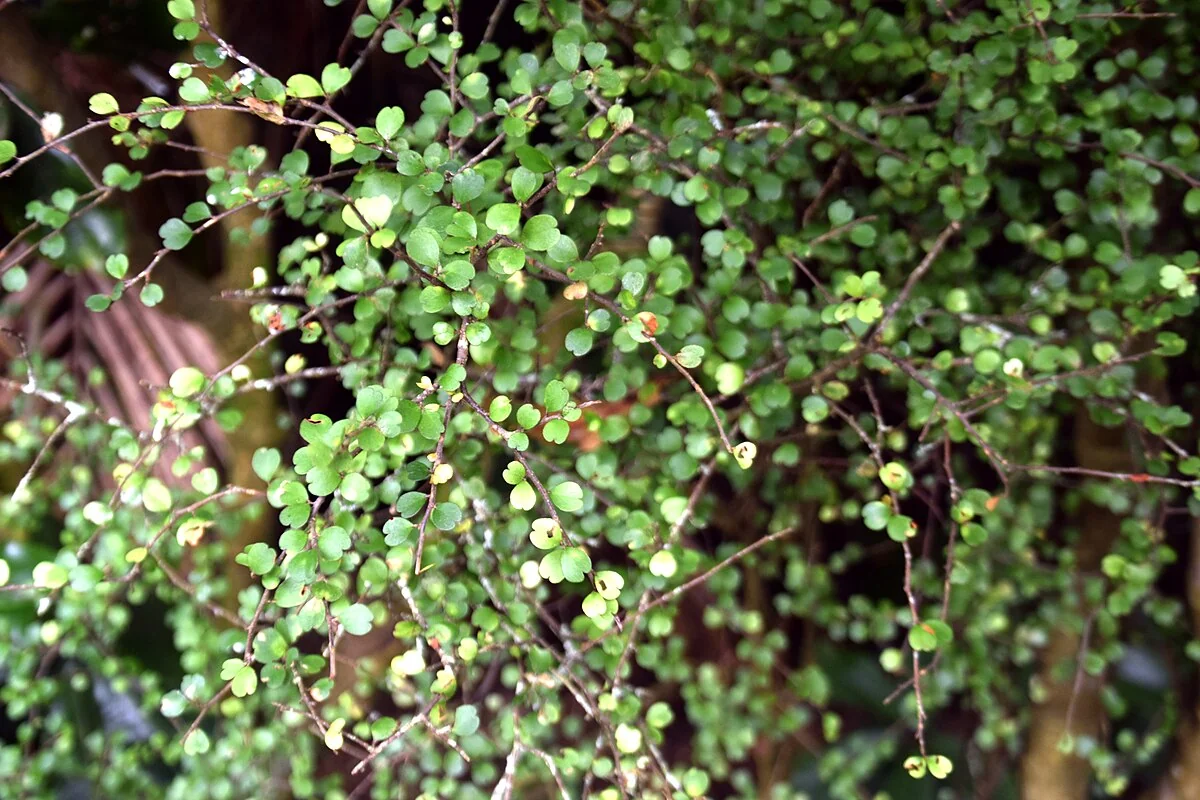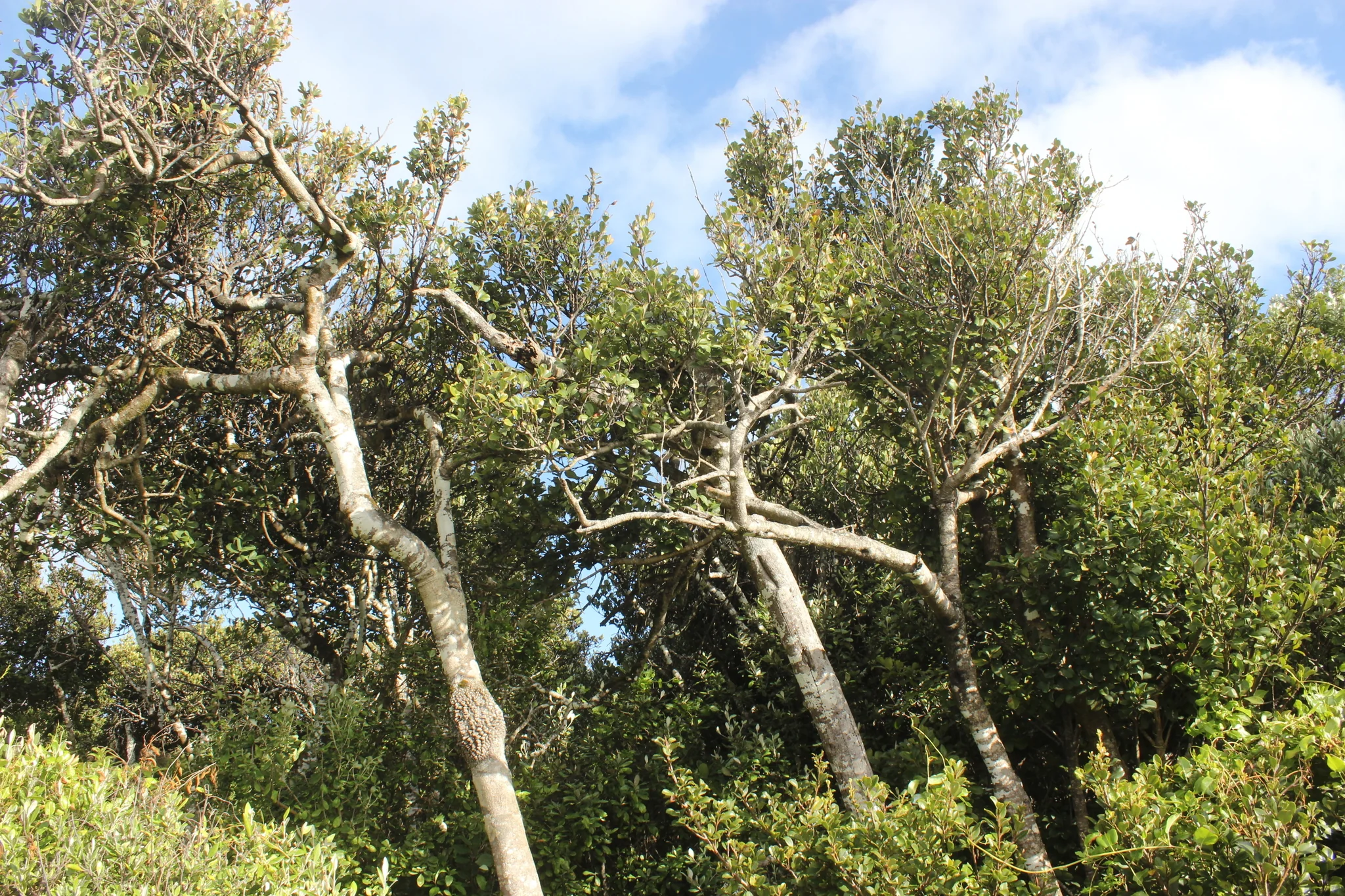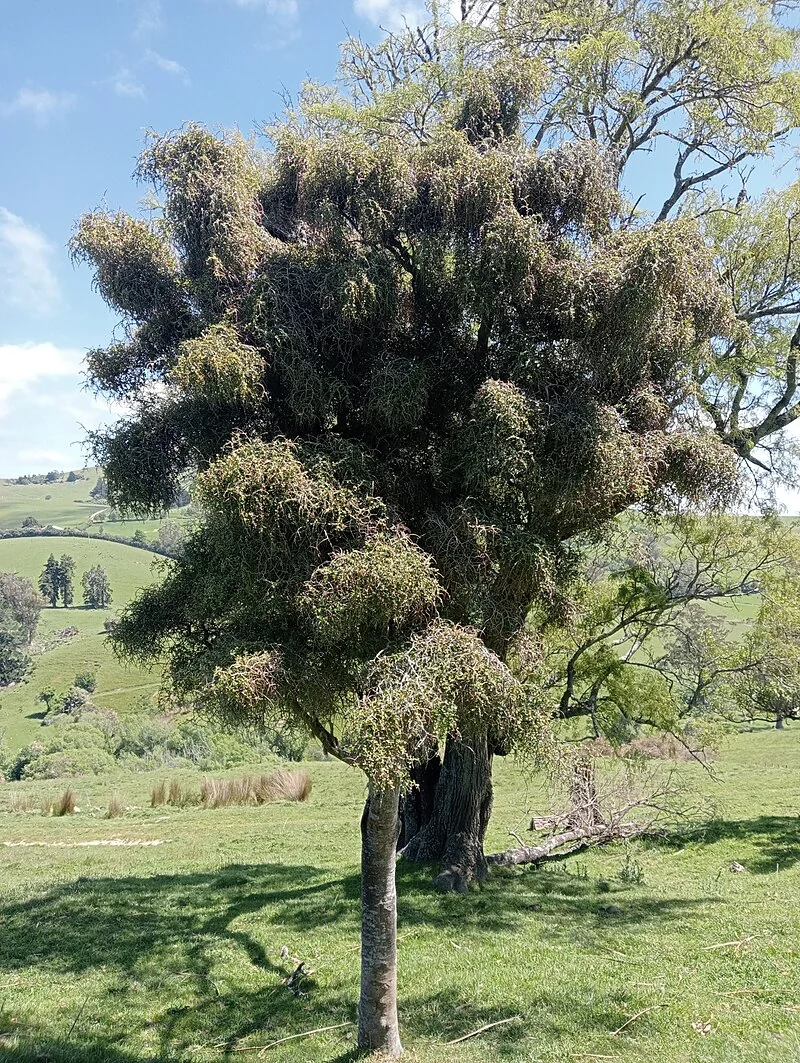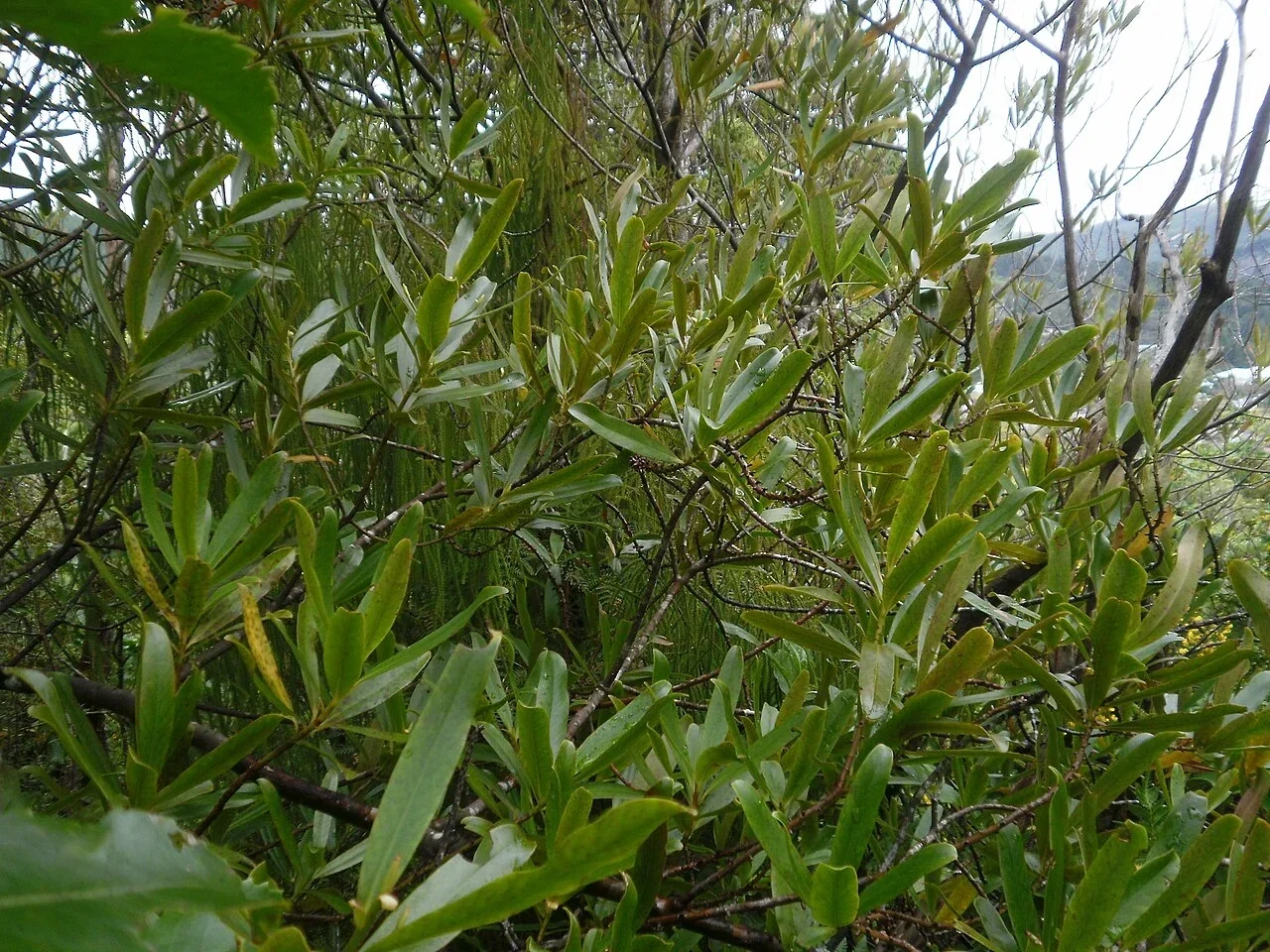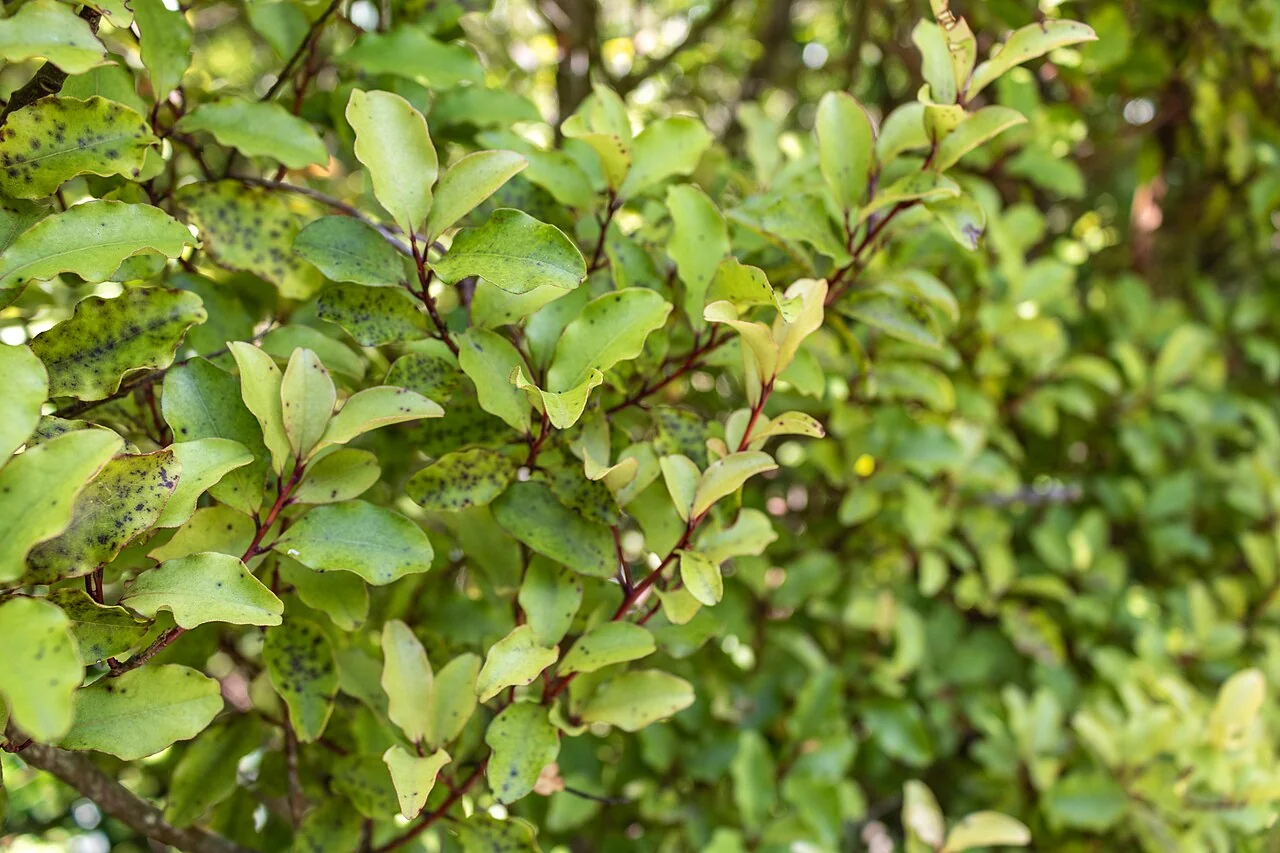
Red Māpou
Myrsine australis
Red Māpou ( Myrsine australis ), also known as māpou, Tipau, or Mataīra, is a common and attractive native New Zealand shrub or small tree, celebrated for its distinctive reddish twigs, undulating leaves, and small, dark purple berries. This evergreen species is found throughout New Zealand, from coastal to montane forests. Its dense foliage and year-round interest make it a popular choice for native plant gardens, hedging, or as a specimen plant. Red Māpou is a resilient and ecologically important plant that adds a touch of natural beauty to any landscape, showcasing the rich biodiversity of New Zealand's forests. For related species, see the native plants index .

Plant Description
Botanical Features
Red Māpou ( Myrsine australis ), also known as Māpou, tāpau, or mātātā, is a native evergreen shrub or small tree found throughout New Zealand. It typically grows 3-6 meters tall, with some reaching up to 7 meters, and has short, upright branches forming a compact crown. The trunk can grow up to 20 cm in diameter, with dark brown/black bark on older branches and reddish bark on juvenile branches, which is a distinguishing feature. The leaves are pale green to yellow-green, often mottled or blotched with red or purple spots, and have a leathery texture. They are typically 3-6 cm long and 1.5-2.5 cm wide, arranged alternately on the stem, and often have strongly undulate (wavy) margins. Inconspicuous, cream to whitish, or pale green flowers are clustered on small stalks and appear between August and January. These are followed by small, 1-seeded drupes that are dark brown to black when mature, produced between September and May.
Quick Facts
| Scientific Name | Myrsine Australis |
|---|---|
| Common Name | Red Māpou, māpou, Tipau, Mataīra |
| Family | Primulaceae |
| Height | Up to 6 m |
| Spread | Up to 3 m |
| Light | Full sun to partial shade |
| Soil | Well-drained, adaptable to most soil types |
| Water Needs | Moderate |
| Frost Tolerance | Moderate |
| Salt Tolerance | Moderate |
| Growth Rate | Medium to fast |
| Lifespan | Long |
Climate Best Suited to
Red Māpou ( Myrsine australis ) is widely distributed throughout New Zealand, from coastal to montane forests, indicating its broad adaptability to various climates. It thrives in mild, temperate climates with consistent rainfall and moderate temperatures. It is reasonably tolerant of wind and some salt spray, making it suitable for coastal gardens, but prefers sheltered locations away from extreme exposure. Its natural habitat includes forest margins, open areas, and stream banks. It can be successfully cultivated in most temperate regions, provided it has good drainage and protection from extreme heat or prolonged severe frosts when young.
Regional Suitability
| Whangārei | Ideal |
| Auckland | Ideal |
| Hamilton | Suitable |
| Rotorua | Suitable |
| Tauranga | Ideal |
| Gisborne | Ideal |
| New Plymouth | Ideal |
| Whanganui | Ideal |
| Palmerston North | Suitable |
| Napier | Ideal |
| Wellington | Ideal |
| Nelson | Ideal |
| Christchurch | Suitable |
| Dunedin | Suitable |
| Invercargill | Suitable |
| City | Climate Suitability |
|---|
Natural Habitat
Typical Environments
Understand the natural habitat of Red Māpou ( Myrsine australis ), which is found throughout New Zealand, in coastal to montane forests. This section details its geographical distribution, preferred environmental conditions, and the types of ecosystems where it naturally occurs.
- Widespread across New Zealand, from sea level to moderate altitudes.
- Found in coastal areas, forest margins, and open forests.
- Prefers well-drained sites with good air circulation.
- Thrives in full sun to partial shade.
Its broad habitat range highlights its adaptability and resilience, making it a fascinating subject for ecological study.
Plant Conservation
Māpou This status has been consistent in assessments from 2004, 2009, 2012, and 2017. The species is endemic to New Zealand and is found throughout the mainland and offshore islands.
Growing Requirements
Soil Requirements
Red Māpou thrives in well-drained, fertile soils. It is adaptable to a range of soil types, including sandy, loamy, and even some clay soils, but good drainage is crucial to prevent root rot. Incorporating organic matter can improve soil structure and moisture retention. A neutral to slightly acidic pH is generally preferred.
- Adaptable to most well-drained soil types.
- Prefers fertile soils with good drainage.
- Tolerates sandy, loamy, and some clay soils.
- Neutral to slightly acidic pH preferred.
Light Requirements
Red Māpou performs well in full sun to partial shade. In full sun, it tends to be denser and more compact, producing more berries. In partial shade, it may grow a bit more open but will still thrive. Ensure it receives adequate light for healthy growth and development.
- Full sun to partial shade.
- Denser growth and more berries in full sun.
- Adaptable to various light conditions.
Water Requirements
Red Māpou requires moderate watering, especially during dry periods and its establishment phase. Once established, it is reasonably drought-tolerant but will benefit from occasional deep watering during prolonged dry spells. Ensure the soil is consistently moist but not waterlogged.
- Moderate watering needs.
- Drought-tolerant once established.
- Avoid waterlogging.
Planting Guide
Best Time to Plant
The best time to plant Red Māpou is during autumn or spring, when temperatures are mild and rainfall is more consistent. This allows the plant to establish its root system before the extremes of summer heat or winter cold.
Choosing a Location
Select a site with full sun to partial shade and well-drained, fertile soil. Red Māpou is highly adaptable and can be planted in coastal areas, exposed sites, or more sheltered garden beds. Ensure it has adequate space for its mature size if not being regularly pruned.
Planting Steps
- Dig a hole twice the width of the root ball and the same depth.
- Gently remove the plant from its container, being careful not to disturb the roots.
- Place the plant in the hole, ensuring the top of the root ball is level with the surrounding soil.
- Backfill with amended soil, firming gently around the base of the plant.
- Water thoroughly immediately after planting to settle the soil.
- Apply a layer of organic mulch to help retain moisture and suppress weeds, keeping it away from the stem.
Initial Care
Water regularly during the first 6-12 months to help establish a strong root system. Once established, Red Māpou is reasonably low maintenance and requires less frequent watering. Protect young plants from strong winds and severe frosts if necessary.
Ecological Role
Ecosystem Roles
The ecological importance of Red Māpou ( Myrsine australis ) within its native New Zealand ecosystems is significant. Its berries provide a crucial food source for native birds, particularly during autumn and winter, aiding in seed dispersal and playing a key role in forest regeneration. Its dense foliage also provides shelter for small birds and invertebrates.
- Berries are a crucial food source for native birds.
- Aids in seed dispersal and forest regeneration.
- Provides shelter for small birds and invertebrates.
- Contributes to biodiversity in diverse forest ecosystems.
As an endemic species, it is an integral part of the unique biodiversity that has evolved in New Zealand, supporting the delicate balance of its natural habitats.
Uses and Significance
Garden Uses
- Excellent hedging and screening plant.
- Suitable for native plant gardens, shelterbelts, and screens.
- Provides year-round interest with evergreen leaves and berries.
- Attracts native birds to its berries.
Cultural Significance
Myrsine australis , commonly known as Māpou or Red Mātipo, holds significant cultural importance, particularly within Māori tradition in New Zealand. It is regarded as a rākau tapu (sacred tree) and has been utilized in various ceremonial, medicinal, and practical ways.
Key Aspects of Its Cultural Significance Include:
- Ceremonial Use: Māpou A staff fashioned from Māpou could also serve as a badge of office for a tohunga.
- Ritualistic Role in Agriculture: Māpou This pole acted as a mauri , a physical representation of Rongo, the guardian of agriculture. The tree was also known as the 'loin cloth of Whānui', the Māori name for the star Vega, which is associated with the origin of kūmara .
- Māpou Māpou
- Practical Uses: Māpou Europeans also used the timber for cabinet making.
- Symbol of Resilience: The plant is recognized for its resilience and adaptability, thriving in various environments and even coping with browsing from introduced mammals due to its unpalatable leaves. This resilience connects it deeply to Māori heritage and the natural environment.
- Ecological Value: Its berries are a crucial food source for native birds, aiding in seed dispersal and forest regeneration, further integrating it into the natural landscape and its cultural appreciation.
Landscaping Applications
Red Māpou ( Myrsine australis ) is a highly attractive and versatile plant for various landscaping applications, particularly in native and low-maintenance gardens. Its distinctive foliage and berries make it a valuable asset.
- Ideal as a specimen shrub or small tree for larger gardens and parks.
- Excellent for native forest restoration and revegetation projects.
- Provides year-round interest with evergreen leaves and berries.
- Suitable for mass plantings or as an accent plant.
Its ability to thrive in sheltered, shaded conditions and its aesthetic appeal make it a popular choice for creating lush and beautiful native landscapes.
Seasonal Care Calendar
Spring
New growth emerges, and inconspicuous flowers may appear. This is an ideal time for planting new Red Māpou specimens or propagating from cuttings. Ensure consistent moisture for young trees and protect them from strong winds if necessary. A light feed with a balanced slow-release fertilizer can encourage vigorous growth.
- Ideal time for planting and propagation.
- Ensure consistent moisture for new plants.
- Light fertilization if needed.
Summer
Red Māpou is actively growing and may produce flowers and developing berries. Consistent watering is important, especially during dry spells, to prevent stress. Monitor for pests and diseases, though it is generally quite resilient.
- Active growth and flowering.
- Consistent watering is essential.
- Monitor for pests and diseases.
Autumn
Berries ripen and become prominent in autumn, providing a valuable food source for native birds. This is another good time for planting, allowing roots to establish before winter. Minimal care is required for established plants, but ensure they remain adequately hydrated.
- Berries ripen, attracting birds.
- Good time for planting.
- Minimal care for established plants.
- Ensure adequate hydration.
Winter
Red Māpou is evergreen and provides year-round interest. It is moderately frost-tolerant and requires minimal care during this period. Ensure good drainage to prevent root issues in wet conditions.
- Evergreen, provides year-round interest.
- Protect young plants from severe frost.
- Ensure good drainage.
When to Prune and How Much
Red Māpou is very amenable to pruning and can be shaped as a hedge, screen, or small tree. Regular pruning helps maintain its desired size and form, and encourages denser growth.
- Light trimming can be done at any time of year to maintain shape.
- For hedging, prune after the main flush of new growth in spring/early summer.
- Heavy pruning to reduce size or rejuvenate can be done in late winter/early spring.
- Remove dead, damaged, or diseased branches as needed.
- Use clean, sharp tools.
Red Māpou responds well to even hard pruning, making it a very forgiving plant for shaping and maintenance.
How to Grow Red Māpou
Growing Red Māpou is remarkably straightforward, making it an excellent choice for both novice and experienced native plant gardeners. This hardy indigenous shrub adapts to a wide range of habitats and growing conditions, establishing easily when provided with basic care. Known for its distinctive red stems, wavy-edged leaves, and excellent hedging potential, Red Māpou serves multiple purposes in the garden while supporting native wildlife. Understanding its natural regeneration patterns and seed bank characteristics helps gardeners work with the plant's inherent tendencies for successful cultivation and establishment.
From Seed
Seed propagation is highly reliable with Red Māpou, though patience is required due to the species' unique germination patterns and seed banking characteristics. Fresh seed provides the best results, and understanding stratification requirements significantly improves success rates and timing predictability.
- Collect ripe fruit when fully black in late autumn to early winter, ensuring seeds are mature and viable
- Extract seeds immediately from fresh fruit and clean thoroughly to remove all fleshy pulp and debris
- Sow seeds directly onto a firm bed of seed-raising mix and press well into the surface
- Cover with a light layer of mix, approximately 2-3mm deep to maintain good seed-to-soil contact
- Apply 4-6 weeks of cold stratification at 4°C to speed up and even out germination timing
- Maintain consistent moisture without waterlogging throughout the germination period
- Expect germination within 2-4 weeks after stratification, though some seeds may remain dormant longer
- Be aware that Red Māpou maintains a natural seed bank, with some seeds germinating randomly over multiple seasons
- Allow germination to take 4-5 times longer than faster-germinating natives like Hoheria species
- Transplant seedlings when they have developed several sets of true leaves and robust root systems
From Cuttings
While challenging, cutting propagation offers a reliable method for maintaining specific plant characteristics and faster establishment than seed. Semi-hardwood cuttings work best when processed with proper equipment and techniques, particularly mist propagation systems.
- Select healthy, disease-free semi-hardwood cuttings 4-6 inches long from current season's growth
- Take cuttings during optimal periods in late summer to early autumn when growth has begun to firm
- Make clean cuts just below a node using sharp, sterilized cutting tools
- Remove lower leaves while retaining 4-6 leaves at the cutting tip to maintain photosynthesis
- Dip cutting bases in rooting hormone containing IBA at appropriate concentration for woody species
- Plant in rooting medium composed of equal parts peat moss and perlite for optimal drainage and aeration
- Utilize mist propagation systems for best results, maintaining high humidity while preventing waterlogging
- Provide bright indirect light and maintain temperatures between 18-22°C for optimal rooting conditions
- Monitor closely for fungal issues and ensure excellent air circulation around cuttings
- Expect rooting within 3-6 weeks, though some cuttings may take longer to establish
- Gradually acclimatize rooted cuttings to normal growing conditions over several weeks
Transplanting and Establishment
Red Māpou establishes readily when planted correctly, adapting to various soil conditions and site characteristics. Proper timing and site preparation ensure rapid establishment and long-term success in garden environments.
- Choose planting sites with full sun to partial shade, providing wind protection for young plants
- Ensure well-draining soil with pH between 6.0-7.5, amending heavy clay soils if necessary
- Plant during cooler months in early spring or fall for optimal root establishment
- Dig planting holes twice as wide as the root ball and incorporate organic matter like compost
- Space plants 1.5-2 meters apart for hedge plantings or allow natural spacing for specimen trees
- Water moderately during establishment, preventing both drought stress and root rot conditions
- Apply organic mulch around plants to conserve moisture and suppress competing weeds
- Monitor young plants for wind damage and provide temporary support if needed
Garden Management and Maintenance
Once established, Red Māpou requires minimal maintenance while providing excellent structure and wildlife value. Understanding its growth patterns and pruning requirements helps maintain desired form and function in garden settings.
- Allow plants to develop naturally for specimen trees or prune regularly for hedge formation
- Trim hedges annually after fruiting to maintain dense growth and encourage new shoots
- Remove any dead, damaged, or crossing branches to improve plant health and appearance
- Take advantage of the plant's natural windbreak qualities in exposed garden areas
- Monitor for natural regeneration from seed bank, managing unwanted seedlings as needed
- Appreciate the plant's drought and frost tolerance once fully established in the garden
- Utilize the species as nurse plants for establishing other slower-growing native species
Pests and Diseases
Red Māpou is generally a robust plant, but it can be susceptible to certain pests and diseases, especially if not grown in optimal conditions.
Common Pests
- Aphids: Can infest new growth. Treat with insecticidal soap or remove manually.
- Scale Insects: May be present on stems and leaves. Treat with horticultural oil or appropriate insecticides.
Common Diseases
- Sooty Mould: Often associated with scale insect infestations, it can cover leaves and reduce photosynthesis. Address the underlying pest issue.
- Root Rot: Caused by overwatering or poor drainage. Ensure well-drained soil.
Good garden hygiene, proper watering, and adequate air circulation are key to preventing most pest and disease issues. Regular inspection will help catch problems early.
Bonus Tip
Expert Growing Advice
The leaves of Red Māpou were traditionally boiled by both Māori and early European settlers to create a liquid used to alleviate toothaches. coopound
